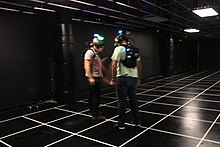
A video game or computer game is an electronic game that involves interaction with a user interface or input device to generate visual feedback from a display device, most commonly shown in a video format on a television set, computer monitor, flat-panel display or touchscreen on handheld devices, or a virtual reality headset. Most modern video games are audiovisual, with audio complement delivered through speakers or headphones, and sometimes also with other types of sensory feedback. Some video games also allow microphone and webcam inputs for in-game chatting and livestreaming.

Digital television (DTV) is the transmission of television signals using digital encoding, in contrast to the earlier analog television technology which used analog signals. At the time of its development it was considered an innovative advancement and represented the first significant evolution in television technology since color television in the 1950s. Modern digital television is transmitted in high-definition television (HDTV) with greater resolution than analog TV. It typically uses a widescreen aspect ratio in contrast to the narrower format (4:3) of analog TV. It makes more economical use of scarce radio spectrum space; it can transmit up to seven channels in the same bandwidth as a single analog channel, and provides many new features that analog television cannot. A transition from analog to digital broadcasting began around 2000. Different digital television broadcasting standards have been adopted in different parts of the world; below are the more widely used standards:
Multimedia is a form of communication that uses a combination of different content forms, such as writing, audio, images, animations, or video, into a single interactive presentation, in contrast to traditional mass media, such as printed material or audio recordings, which feature little to no interaction between users. Popular examples of multimedia include video podcasts, audio slideshows, and animated videos. Multimedia also contains the principles and application of effective interactive communication, such as the building blocks of software, hardware, and other technologies. The five main building blocks of multimedia are text, image, audio, video, and animation. The first building block of multimedia is the image, which dates back 15,000 to 10,000 B.C. with concrete evidence found in the Lascaux caves in France. The second building block of multimedia is writing, which was first scribed in stone or on clay tablets and was mostly about three things. Property, conquest, and religion. Writing was soon abstracted from visual images into symbols that represented the sounds we make with our mouths. Thanks to the Egyptians, writing was evolved and transferred from stone to Papyrus. A cheaper but more fragile canvas derived from strips of the papyrus root grown on the Nile River.

Virtual reality (VR) is a simulated experience that employs pose tracking and 3D near-eye displays to give the user an immersive feel of a virtual world. Applications of virtual reality include entertainment, education and business. Other distinct types of VR-style technology include augmented reality and mixed reality, sometimes referred to as extended reality or XR, although definitions are currently changing due to the nascence of the industry.

Augmented reality (AR) is an interactive experience that combines the real world and computer-generated content. The content can span multiple sensory modalities, including visual, auditory, haptic, somatosensory and olfactory. AR can be defined as a system that incorporates three basic features: a combination of real and virtual worlds, real-time interaction, and accurate 3D registration of virtual and real objects. The overlaid sensory information can be constructive, or destructive. This experience is seamlessly interwoven with the physical world such that it is perceived as an immersive aspect of the real environment. In this way, augmented reality alters one's ongoing perception of a real-world environment, whereas virtual reality completely replaces the user's real-world environment with a simulated one.

THX Ltd. is a suite of high fidelity audiovisual reproduction standards for movie theaters, screening rooms, home theaters, computer speakers, video game consoles, car audio systems, and video games. The THX trailer that precedes movies is based on the Deep Note, with a distinctive glissando up from a rumbling low pitch.

Home cinema, also called home theaters or theater rooms, are home entertainment audio-visual systems that seek to reproduce a movie theater experience and mood using consumer electronics-grade video and audio equipment that is set up in a room or backyard of a private home. Some studies show that films are rated better and generate more intense emotions when watched in a movie theater, but convenience is a major appeal for home cinemas. In the 1980s, home cinemas typically consisted of a movie pre-recorded on a LaserDisc or VHS tape; a LaserDisc Player or VCR; and a heavy, bulky large-screen cathode ray tube TV set, although sometimes CRT projectors were used instead. In the 2000s, technological innovations in sound systems, video player equipment and TV screens and video projectors have changed the equipment used in home cinema set-ups and enabled home users to experience a higher-resolution screen image, improved sound quality and components that offer users more options. The development of Internet-based subscription services means that 2020s-era home theatre users do not have to commute to a video rental store as was common in the 1980s and 1990s.
Technological convergence is the tendency for technologies that were originally unrelated to become more closely integrated and even unified as they develop and advance. For example, watches, telephones, television, computers, and social media platforms began as separate and mostly unrelated technologies, but have converged in many ways into an interrelated telecommunication, media, and technology industry.

Mixed reality (MR) is a term used to describe the merging of a real-world environment and a computer-generated one. Physical and virtual objects may co-exist in mixed reality environments and interact in real time.

A home theater PC (HTPC) or media center computer is a convergent device that combines some or all the capabilities of a personal computer with a software application that focuses on video, photo, audio playback, and sometimes video recording functionality. Since the mid-2000s, other types of consumer electronics, including game consoles and dedicated media devices, have crossed over to manage video and music content. The term "media center" also refers to specialized application software designed to run on standard personal computers.
Strictly, digital theatre is a hybrid art form, gaining strength from theatre's ability to facilitate the imagination and create human connections and digital technology's ability to extend the reach of communication and visualization.
Video game culture or gaming culture is a worldwide new media subculture formed by video game hobbyists. As video games have exponentially increased in sophistication, accessibility and popularity over time, they have had a significant influence on popular culture, particularly among adolescents and young adult males. Video game culture has also evolved with Internet culture and the increasing popularity of mobile games, which has led to an increase in the female demographic that play video games.

A digital media player is a type of consumer electronics device designed for the storage, playback, or viewing of digital media content. They are typically designed to be integrated into a home cinema configuration, and attached to a television or AV receiver or both.

Immersion into virtual reality (VR) is a perception of being physically present in a non-physical world. The perception is created by surrounding the user of the VR system in images, sound or other stimuli that provide an engrossing total environment.

OnLive was a provider of cloud virtualization technologies based in Mountain View, California. OnLive's flagship product was its cloud gaming service, which allowed subscribers to rent or demo computer games without installing them. Games were delivered as streaming video rendered by the service's servers, rather than running on the local device. This setup allowed the games to run on computers and devices that would normally be unable to run them due to insufficient hardware. OnLive also enabled other features such as the ability for players to record gameplay and to spectate.

4K resolution refers to a horizontal display resolution of approximately 4,000 pixels. Digital television and digital cinematography commonly use several different 4K resolutions. In television and consumer media, 3840 × 2160 with a 16:9 aspect ratio is the dominant 4K standard, whereas the movie projection industry uses 4096 × 2160.
A smart TV, also known as a connected TV (CTV), is a traditional television set with integrated Internet and interactive Web 2.0 features that allow users to stream music and videos, browse the internet, and view photos. Smart TVs are a technological convergence of computers, televisions, and digital media players. Besides the traditional functions of television sets provided through traditional broadcasting media, these devices can provide access to over-the-top media services such as streaming television and internet radio, along with home networking access.
Dolby Atmos is a surround sound technology developed by Dolby Laboratories. It expands on existing surround sound systems by adding height channels, allowing sounds to be interpreted as three-dimensional objects with neither horizontal nor vertical limitations. Following the release of Atmos for the cinema market, a variety of consumer technologies have been released under the Atmos brand, using in-ceiling and up-firing speakers.
A transreality game, sometimes written as trans-reality game, describes a type of video game or a mode of gameplay that combines playing a game in a virtual environment with game-related, physical experiences in the real world and vice versa. In this approach a player evolves and moves seamlessly through various physical and virtual stages, brought together in one unified game space. Alongside the rising trend of gamification, the application of game mechanics to tasks that are not traditionally associated with play, a transreality approach to gaming incorporates mechanics that extend over time and space, effectively playing through a players day-to-day interactions.

A virtual reality game or VR games is a video game played on virtual reality (VR) hardware. Most VR games are based on player immersion, typically through head-mounted display unit or headset with stereoscopic displays and one or more controllers.













